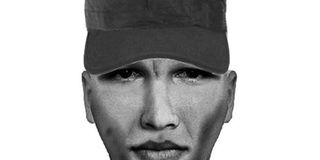Kaweesi shooting: Did composite images match eye witness descriptions?

The Uganda Police have arrested more than 15 suspects basing on the released composite images of suspects in the assassination of Assistant Inspector General of Police (AIGP) Andrew Felix Kaweesi.
Kaweesi, the former police spokesperson was gunned down on March 17th alongside his driver Godfrey Wambewo and bodyguard Kenneth Erau. Unknown gunmen ambushed the car in which the three were travelling and sprayed it with bullets less than a kilometre away from Kaweesi's home in Kulambiro, a Kampala suburb.
Just hours after the shooting incident, the police circulated composite images of people they thought were the prime suspects. The first composite image was released barely three hours after Kaweesi was gunned down and subsequently others came out in the days that followed with the latest having been released on the night of Tuesday, March 21, hours after Kaweesi was buried at his home in Lwengo district.
Wambewo and Erau had been buried a day earlier at their respective homes in Mbale and Amuria districts.
According to The American Academy of Forensic Sciences (AAFS), a composite image uses descriptions given by witnesses to create a drawing that is a useful tool for identifying or ruling out a suspect. A composite drawing is not intended to be a portrait of an individual, but more of a two-dimensional likeness that is a visual record of the witness' recollections.
These images are used mostly by police in investigations. Composite artists come up with an image of a suspect's face in hope of identifying them.
The Kampala Metropolitan Political Commissar and spokesperson Emilian Kayima said that detectives interviewed eyewitnesses at the crime scene in Kulambiro and used their descriptions to come up with an illustration.
"The eyewitnesses described all the features on the faces of the people they saw shooting at Kaweesi, his bodyguard and driver," Kayima says.
However, all the witnesses talked to at the scene of crime indicated that despite seeing four people at the scene of crime, they could not make out the colour of their clothes leave alone the features on their faces.
One of the witnesses who were at the nearby boda boda stage says he saw four people dressed in black jackets and head scarves.
"I would be lying if I said I saw them well. There were so many bullets being fired. When I tried to peep at them they saw me and fired towards me. I dived for my life hitting my head hard," the witness says.
Asked what type of motorcycle the assailants were riding on, three of the witnesses could not answer.
But Kayima insists the police experts worked with eyewitness descriptions to come up with the images. "Our sketch artists put together the described features using a computer and then asked the witnesses whether the images had a likeness to the persons they saw," Kayima says.
This is the third time the Uganda Police Force has used facial composite images in an attempt to identify suspects in prominent cases.
It was first used in 2010 after the July 11th twin bombing at Kyadondo and Ethiopian Restaurant in which at least 80 people were killed. A composite sketch was also made when State prosecutor Joan Kagezi was gunned down in Kiwatule, a Kampala suburb, on March 30, 2015.
In 2010, detective agents from America's Federal Bureau of Investigations (FBI) who flew in to help with investigations made the composite sketches. The images were made public through social media and pinned at all police units around the country. The images helped identify one of the suspects who later led to the arrest of the remaining suspects.
The one of Kagezi's case has not helped much in the investigations which are still dragging on.
Initially, a traditional method of making composite images was used which includes a sketch artist using his/her pencil to sketch the face being described. This method however had 5% chance that the sketch matched the suspect.




